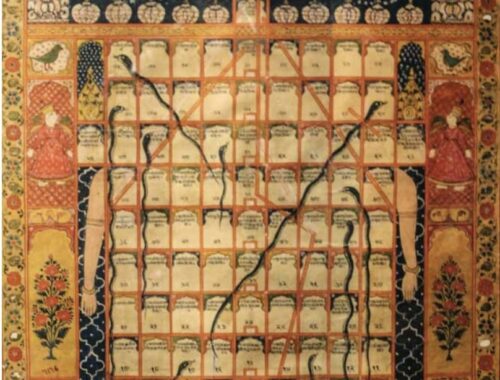
Yellow dock root: badger medicine for a new story
Five years ago, I made a batch of yellow dock root tincture, for no reason at all at the time. It sat stewing silently in the back of my medicine cabinet, waiting for the moment to make its debut. That came in early spring this year, when Freya had a digging frenzy in the garden. She’s not much of a digger usually, so after one especially strenuous effort, I went out to inspect her work. You guessed right! She had dug up an enormous yellow dock and was chewing on the root.
Freya is a rescue dog, so we don’t know her history, but all animals, including humans, will self-medicate given the chance. We do know that she had a full slew of vaccinations just before we got her and when she arrived here, her back was severely hunched and her back legs were stiff, almost paralyzed. She couldn’t run. I suspect that the rabies vaccination was involved, as the shelter did not mention that she had had an injury or any problems before she came to us. Her back eventually straightened, but she still sticks her hind legs out to the side when she runs. She also has other health challenges and some difficulty in managing her emotions.
However, this post isn’t about Freya’s various conditions and how we treat them; I’m aiming to show how the process of guidance and learning unfolds when working with a plant teacher, how to work with the resources available and how perception shifts.
According to Culpeper’s Complete Herbal, all the docks are governed by Jupiter and yellow dock is turning out to be a quite outstanding teacher plant.
“Government and virtues. All docks are under Jupiter, of which the red dock, which is commonly called blood-wort, cleanseth the blood, and strengthens the liver; but the yellow dock-root is best to be taken when either the blood or liver is affected by choler. All of them have a kind of cooling (but not all alike) drying quality, the sorrel being most cold, and the bloodworts most drying. Of the burdock, I have spoken already by itself. The seed of most of the other kinds, whether the gardens or fields, do stay lasks and fluxes of all sorts, the loathing of the stomach through choler, and is helpful for those that spit blood. The roots boiled in vinegar helpeth the itch, scabs, and breaking out of the skin, if it be bathed therewith. The distilled water of the herb and roots have the same virtue, and cleanseth the skin from freckles, morphew, and all other spots and discolourings therein.”
It’s imperative not to lose your nerve when working with animals. I don’t take our animals to the vets (accidents and neutering aside) not because I feel confident in treating them, but because there is no other choice. Vets, just like doctors, are trained by corrupt institutions into a system that does more harm than good – yes, I know your vet is a wonderful, caring individual, especially when it comes to his/her bank account. The vast majority are not caring enough to question the dogma of injecting our animals with harmful substances for questionable diseases. (See: http://www.whale.to/v/rabies.html) They are incapable of treating the injuries and ongoing disease they have inflicted until they recognize that vaccinations cause many of the problems. Animals are the most excellent teachers of the healing arts, Sophia’s emissaries, no less.
I hadn’t even considered giving Freya yellow dock, but dogs don’t lie, so I dug out the tincture and gave her a few drops immediately. I also began taking it myself, so I could get the feel of it from the inside as I began observation and research.
Yellow dock (Rumex crispus): identfication and use
Yellow dock is named after its root, which is yellow and is the part of the plant with the most therapeutic benefit. It is said that the leaves can be eaten, and I’ll put a few young ones in our wild juice now and then for a hint of bitter-sour if there aren’t any dandelion or milk thistle leaves around, but not that often as the oxalates in the leaves interfere with mineral absorption in large amounts and it’s just not worth the bother. It’s the root that I’m interested in.
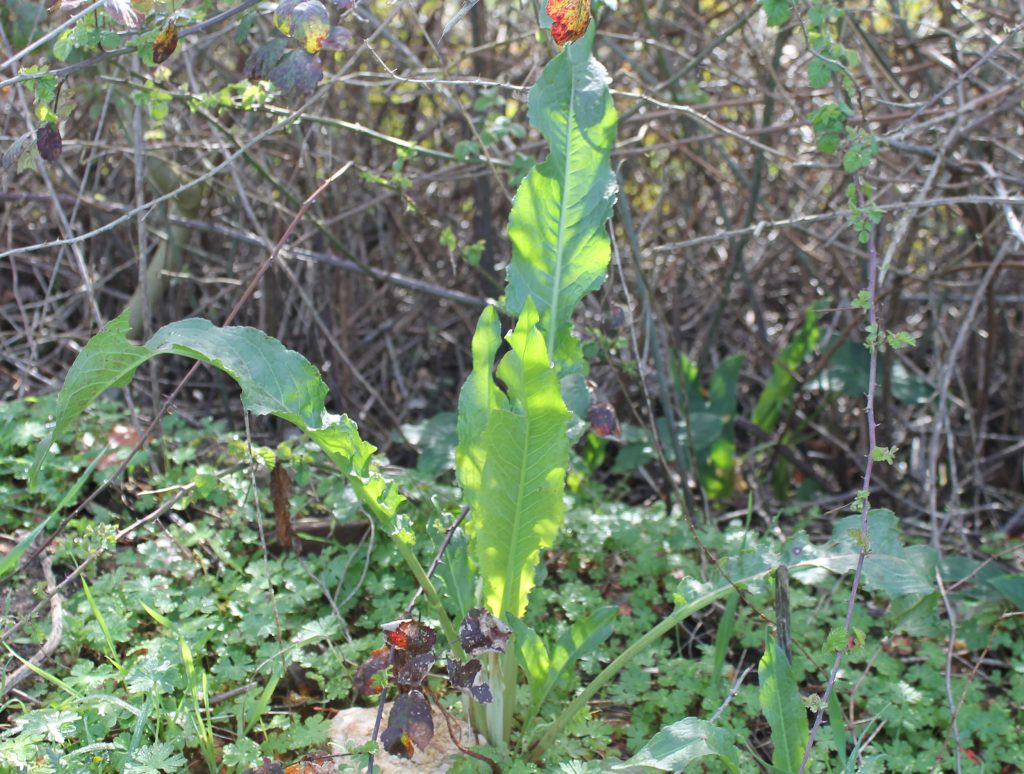
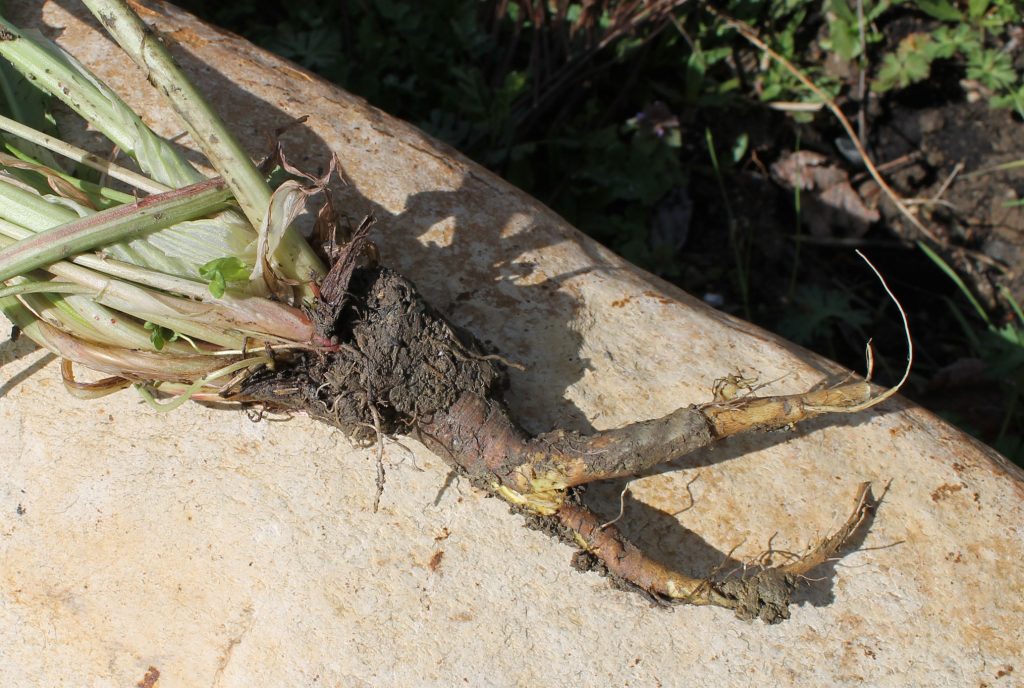
Docks and sorrels are classified as Rumex and are part of the buckwheat, Polygonaceae family, commonly referred to as the knotweed family. They are native to Europe, but have naturalised in most temperate parts of the world. There are several kinds of dock plant, but the one of greatest therapeutic benefit is yellow dock, also known as curly dock. It goes by the botanical name of Rumex crispus due to the wavy edges of its long pointed leaves. It is easily confused with Rumex obtusifolius, aka broad leaved dock or butter dock. The plants have different habitat preferences; yellow dock likes verges, borders and edges and broad leaved dock likes to be the middle of things and its leaves are distinctively tougher and more bitter. I don’t know how the two plants compare biochemically, but these differences tell me that one cannot be substituted for the other.
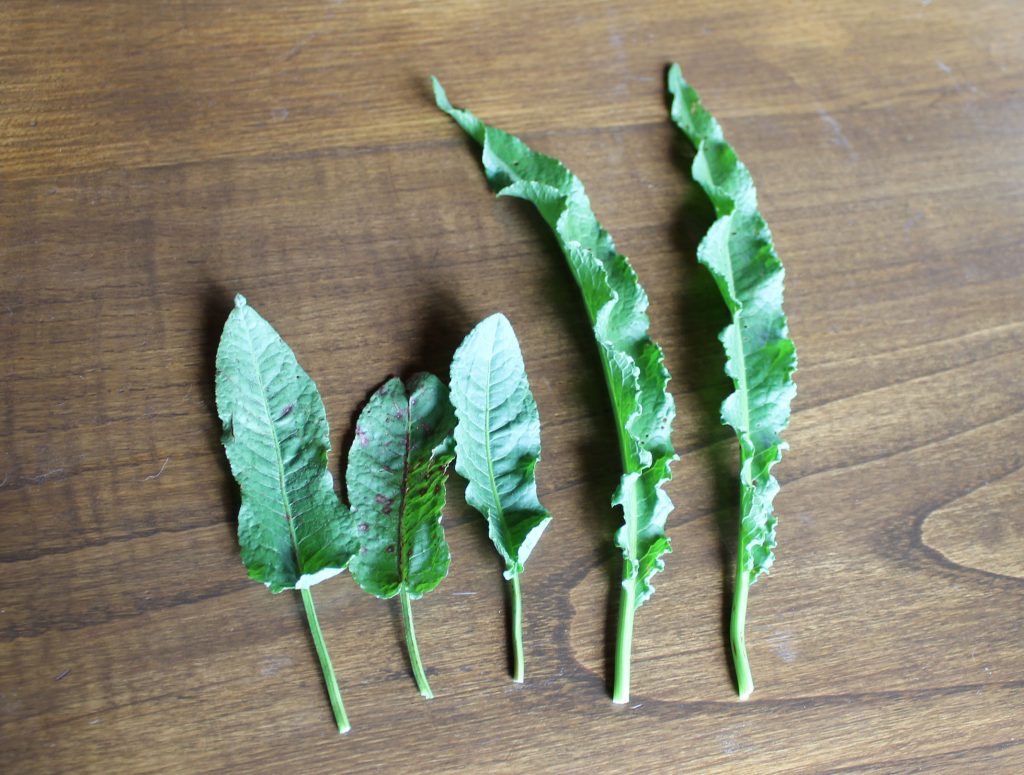
Traditionally, yellow dock root is harvested in late summer/autumn after the seeds turn red. This allows for the plant to achieve maturity and for the seeds to propagate. It is generally considered to be a perennial plant, in that it will usually live for more than two years, if conditions allow. Obviously, when you dig up a plant for its roots, that’s it for that plant, so letting it seed first ensures that there will be future plants. I don’t think there is likely to be any shortage of yellow dock anytime soon, although the population density does vary from year to year. This year is a big yellow dock year – they are everywhere. I harvested in the autumn first, but I’ve just dug up some more in late spring, by the waning moon so that its energy has gone into the roots.
When it comes to deep learning relationships with plant teachers, I prefer getting to know them where they grow and then working with tinctures and sun oils. I use infusions and salves for tonics, refreshment and minor ailments, rather than learning. Time of harvesting does make a difference to the effectiveness of the medicine, particularly with regard to the season, the time of day and the relationship between the planets and the moon. I don’t reduce the plant material to ash for reincorporation in tinctures, because I don’t have the equipment and I see this process as depicting what goes on in the cauldron of your own hermetic vessel. The conjunction of spagyrics, plant alchemy, is the recombination of the essence or spirit of the plant, with your DNA, which transpires in your belly.
Yellow Dock, Anthraquinones, Hydrogen Peroxide and Detoxification
Before using it, I had the general view that Yellow dock root was for the liver, gall bladder and digestive system. It’s such a strong plant that I’d naturally thought that its medicine is best kept for severe issues, but it is actually very mild and safe. Some sites say that it shouldn’t be used by pregnant or breastfeeding women, because of its anthraquinones, but senna has a higher anthraquinone content and is considered safe for occasional use during pregnancy. Much is made of yellow dock’s mild laxative effect, but you’d probably have to take a lot more than I did for that to be even noticeable.
We started with a half-dropper twice a day, once in the morning and once in the afternoon when the bladder and kidney meridians become active (3-7pm). It has a bitter taste, typical of plants that support the gall bladder and liver, that was more unpleasant to us human guinea pigs than it was to Freya. After her first dose, she relaxed into a trance-like state. She is very sensitive and this is her usual response to something that works for her, as her brain and body process the new information. Over the next few days her ravenous appetite diminished slightly, along with her aggression. Her natural demeanor is sweet and playful, but the bouts of candidiasis, UTIs and digestive issues make her irritable at times. Then I noticed something odd.
After taking the yellow dock root tincture for a couple of weeks, sitting down one evening I caught an unmistakable whiff of hydrogen peroxide. I could not work out where it was coming from, I couldn’t even tell whether it was internal or external to my own body! It turns out that yellow dock contains anthraquinones, which are used in the industrial production of hydrogen peroxide and it’s quite likely that they are also involved in making hydrogen peroxide in the body. Why would the body make its own hydrogen peroxide?
For many years, hydrogen peroxide was considered to by cytotoxic, but it turns out to be “[A] ubiquitous molecule. We exhale it, excrete it and take it in from diet.” Hydrogen Peroxide: Ubiquitous in Cell Culture and In vivo?
From Hydrogen Peroxide and Scientific Dogma:
“[P]eroxides are ubiquitous in living systems (again see the Halliwell paper). In higher life forms H2O2 is produced in vivo by monoamine oxidase, xanthine oxidases, various dismutases, and other enzymes, under homeostatic control. There’s substantial evidence that hydrogen peroxide is a widely used signaling molecule (see references 21 to 26 in the Halliwell paper) and recent work has shown a role for hydrogen peroxide in reparative neovascularization. Recruitment of immune cells to wounds likewise appears to require hydrogen peroxide.
Far from being toxic, hydrogen peroxide is an important biomolecule, essential to ordinary metabolic processes. There is zero evidence that hydrogen peroxide does anything harmful in living tissues, at the concentrations normally found in vivo.”
The writer goes on to give his theory as to why scientific dogma sustains, regardless of the evidence:
“Why do myths like this take hold in science? Why do otherwise intelligent scientists cling to them and perpetuate them, regurgitating them in textbooks and handing them down to new generations of students?
I think the answer is, because it makes a good story, and as human beings we value a good story more than we value checking out the story to see if it’s true (providing it’s a suitably satisfying story).
Before there was science, stories were all the human race had as a way of trying to understand the universe. If someone told a good enough story, and the story provided a satisfying-enough explanation of something, the story endured. Some of humankind’s most cherished stories have survived for thousands of years. They survive, in many cases, even if they’re not verifiably true.
With science, the theory is the unit of storytelling. If a theory seems to fit the facts, it’s accepted. If, on closer inspection, a story is found not to fit the facts, it will still be accepted by many people, if it’s a satisfying enough story.”
But I’m still left ‘story-less’ regarding the function of hydrogen peroxide in the body. Some researchers conclude that it might be involved in the regulation of renal function and as an antibacterial agent in the urine. Others theorize that when the immune system is activated in response to bacteria, large amounts of hydrogen peroxide are produced by certain cells to fight the infection and that there is another molecule, peroxiredoxin, that converts hydrogen peroxide back to water if the levels get to high. In plants, hydrogen peroxide is thought to play a key role in stress perception, signaling, and acclimatization to metal toxicity.
Myopic scientists hang onto Darwin’s little tale like drowning sailors in a sea of alphabet soup. Compared to their turgid descriptions of interactions between bit-part players with long names, Darwin’s story is a masterpiece. At least his characters were alive. Internet research on any science related topic will take you into an endless maze of dead-ends and side-tracks, paved with fools gold. The facts presented are true enough within their limited context, but they are only a facsimile of real life. You can put them together in any way you want and find support for any theory you can conceive, but that won’t make your story true. Interactions and relationships that have been observed so meticulously in a laboratory, by scientists pretending to have no effect on the outcome of their experiments and totally ignorant of any effect their experiments might have on themselves, do not describe what happens in a living creature, with its unique ecology, experience and even desires. So why bother with internet research? I think of it as looking for the golden thread in the labyrinth. I scan the material quickly, with open-minded scepticism, looking for what tweaks my attention.
Hydrogen peroxide, the signaling molecule, had waved right up my nose. But what was the message? The very next day a friend from England arrived for a visit. She took the train from the airport to our local station and it was a bit late. She explained that they’d got held up in Os Peares, where she looked at an interesting mural, until a man came out of the station, put on a red hat, blew his whistle and waved a little red flag to signal the all clear for the train to move forward. She found that action immensely charming. I saw it as the message for Freight-Train-Freya, that we were on track yellow dock and had the all clear to continue working with it on what was fundamentally a clearing the way process.
Amongst herbalists, yellow dock is universally highly regarded and there are many sites that describe the kind of conditions it helps with. One of my favourite hard copy references is: The Energetics of Western Herbs, by Peter Holms. Here is an extract from his Notes on yellow dock:
“Yellow dock is one of the many members of the knotweed family found worldwide. Like them, the root of the various species of the yellow or narrow-leaf dock is used as an important resolvent detoxificant remedy. Because Yellow Dock chooses a variety of pathways for accomplishing the job of detoxification, it ensures good results across a brad spectrum of toxicosis conditions. Toxin elimination is comprehensively favoured through the liver, the kidneys and bladder, and the colon.
Primarily, however, Yellow dock root is a bitter digestive stimulant (and cholagogue) that operates by reducing Qi stagnation of the liver, gall bladder and intestines. Because of its dry, cold nature, the root is best used in individuals presenting liver congestion that tend to generate damp heat, typically seen with symptoms such as bilious headache, jaundice, fatty indigestion, chronic constipation and a tendency to food allergies. Its moderate yet certain laxative action is signalled by the anthraquinone glycosides. For the same reason the remedy relieves the symptoms of toxic heat, intestines damp heat and gastric ulcer, where Yellow dock’s anti-inflammatory and astringent actions engage.
Yellow dock at the same time is a kidney stimulant that reduces acidosis and bladder deposits, and promotes urination – where the anthraquinones are active. Its detoxicant and depurant diuretic action here reinforces the detoxicant digestive effect. The net result: an effective remedy for congestive disorders of the skin and lymph. Yellow dock releases wind damp and heat in the skin and therefore addresses a wide range of eczemas presenting itching, redness and vesicular suppuration. Swollen lymph glands likewise benefit from the remedy’s ultimate lymphatic decongestant action.
In the West Yellow dock has a particular reputation for treating anemia. It is also a fact that the root is high in minerals, including iron. However, we must guard against making the statement that Yellow dock literally “nourishes the blood” in the traditional sense of tonifying metabolic functions. Nothing could be further from the truth. The fact is that Yellow dock is clearly a draining, detoxicant remedy for prime use in congestive, hot and damp heat conditions – the exact opposite of what’s required when treating blood deficiency, which is essentially a weak condition.”
Online, I find Richard Whelan’s site to be especially useful.
He has this to say on the mineral content of Yellow dock:
“Yellow dock is a mineral-rich herb; it soaks up trace minerals from the soil and transposes them into an organic form that can easily be absorbed and herbalists of old used to sprinkle iron filings on the soil on which they grew Yellow Dock to treat anaemia and blood deficiency (my comment – the amounts of iron or other minerals in Yellow Dock are likely to be very modest in the doses we typically use, however its broader tonic effects on the liver and gut in turn enable a better absorption of nutrients from the diet and it may be this that has seen it be able to help in cases of anaemia and depletion)”
From an alchemical perspective, there is a golden thread to follow where ever inorganic minerals, especially metals, are involved in biological processes. For a number of years, I’ve been contemplating the notion that microbes and minerals are key to the detoxification/purification actions needed to render the internal terrain hostile to parasites of all types and dimensions. It’s one of the reasons why we wild juice in winter months when wee don’t have fresh vegetables from the garden. A compromised and stressed immune system, that is constantly trying to attack heavy metals, pathogens and foreign biological material in the bloodstream, which it was never designed to deal with, needs help. My insight on the action of iron in Yellow dock is that it’s not a nutrient, but it works with hydrogen peroxide as a kind of Fenton reaction in the body to clean out wastes. The Fenton reaction is used to clean industrial waste water, but is said to be damaging in living systems. That is just another story based on misunderstanding of the role of hydrogen peroxide and has never been observed in a living creature.
Badger Medicine – the Keeper of Stories
To wrap up this post, I turned to another of my favourite reference books: The Earthwise Herbal, by Matthew Wood and this is what I found:
“The leaf of yellow dock is sour, like the leaves of its cousins sheep sorrel and garden sorrel. It is also somewhat astringent. In the root of the dock these tastes and properties are modified by the addition of bitters. Thus the plant is cooling (sour), binding or drying (astringent), cleansing, laxative and alterative (bitter). In terms of the doctrine of signatures, yellow dock is a yellow, man shaped root that helps downward movement in the digestive tract. This is a picture of a “badger medicine” in American Indian practice. My friend Kim Dudley, herbalist in Canberra, Australia, recognized the experience and commented from his experience, “Yellow dock is for excess badger energy.” That would be too much fire in the stomach and digestive tract, too much appetite and too much emotional energy.”
I could see Badger characteristics of aggression, persistence, quick to anger, a liking for solitude and willingness to fight for what you want in Freya, and also in myself. Badger is also said to be the keeper of the medicine roots and in some Native American myths is keeper of the stories.
In order to heal and regenerate, you need a story that is conducive to those aims. The mainstream narrative, regarding the inevitability of disease and degeneration that your body cannot repair, is a slow-acting poison on your unconscious mind, causing you to mistake signs of healing for symptoms of disease, so that you become an unwitting accomplice to your own demise. Yellow dock badger medicine goes right to the root of disease, freeing your mind from the false stories that inhibit your innate healing abilities as it detoxifies your body.
Freya has begun a new chapter in her story; for a long time she was ‘our problem child’ but now she is my teacher and some of her problems are beginning to ease (she has stopped digging in the garden too). I’ve also started a new chapter. I stopped doing therapy/healing work nearly five years ago, as there were other things I wanted to learn. Recently, I’ve been yearning to feel part of the community here, but it seemed like an impossible challenge as we don’t have cows or kids and barely speak the language. (The local dialects even vary from town to town.) Last week, I told Dean that I was thinking about returning to healing work, not working in a therapy rooms in town, but in a more organic way, somehow. The very next day I had three ‘clients’ here, one of whom is going to help me improve my Spanish, in return for me teaching her about the local healing plants.
Badger medicine digs deep and works fast!

Addendum
At the beginning of the next shift, Zuby inexplicably made a bid for freedom and flew over the fence of the chicken pen. Izzy caught him immediately. Luckily, we got him back in and he lost only his tail feathers – and a nasty gash on his back. Not even, wounded pride. He actually seems quite proud of himself!
I was wondering how long to keep giving Freya the yellow dock root tincture and I took this as a sign to stop – Zuby, signalling a new ‘tale’ is on the way. Sure enough, a few weeks later and Freya appears, almost completely healed. See Healing the Waters for more info.

Eco-house build
Healing the Waters
You May Also Like
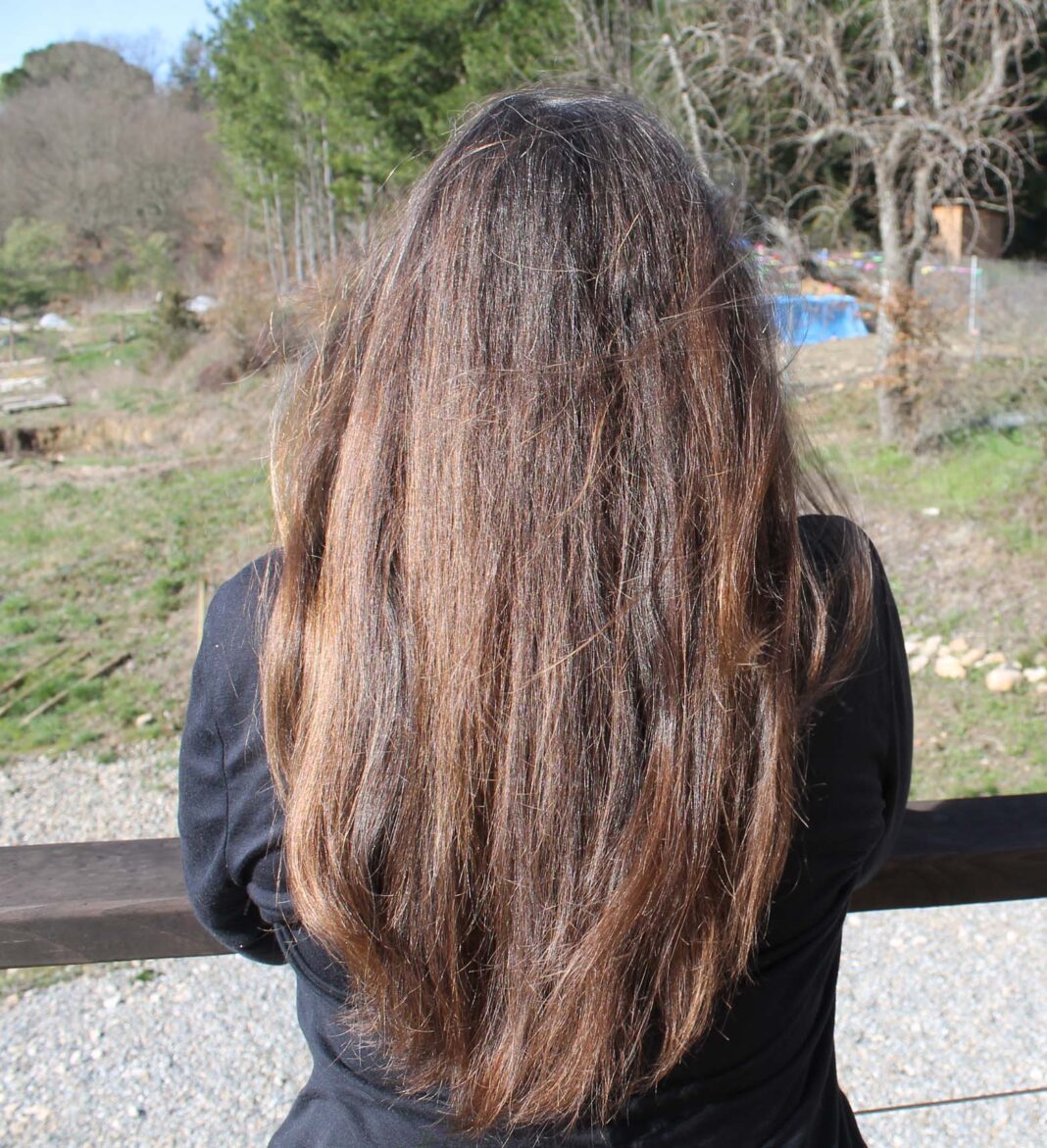
Natural coconut milk shampoo
November 27, 2013
Fascia is the Cosmic Web
June 3, 2025